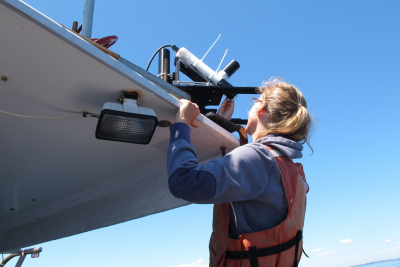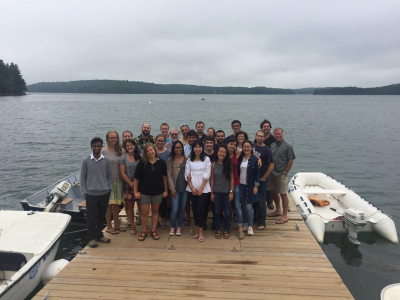- Graduate School GLOMAR
- PhD student reports
- Other activities
- Julia Oelker
Julia Oelker
Report of GLOMAR PhD Julia Ölker about her participation in the Calibration and Validation of Ocean Color Remote Sensing at Darling Marine Center of the University of Maine, USA, from July 10 to August 5 2017.
The Ocean Optics Class is a four week intensive training course that has been taking place every two years since 1985. For a few years now, the Ocean Optics Class is held at the Darling Marine Center of the University of Maine. It is one hour away from Orono, where the main campus of the University of Maine is situated, and is located directly at the Damariscotta river estuary. The class was funded by NASA and the University of Maine.
Among more than 100 applicants, I was lucky to be one of the 20 accepted students. Most of the class’s students either work in the US or have a US citizenship since the course is funded from American grants. From outside the US, only two Europeans and one Israeli participated in the course.
During the course, all the students lived together in housing of the Darling Marine Center. Four instructors that are top professors in the field of ocean optics were present for the entire four weeks to teach us. Further guest lecturers visited from other institutions, most of them being scientists at NASA’s biogeochemical section.
The class syllabus stretched over four weeks. The first two weeks, we had lectures in the morning, lab work after lunch, and we processed and analyzed the data from the labs after dinner until midnight to present them the next morning before the first lecture. Week three and four were structured similarly except we additionally went on a one-day cruise off the coast of Maine for collecting field samples and we started working independently on small group projects. I thought the course was very well organized. Directly applying knowledge from the lectures in the labs and then processing and analyzing the data afterwards helped for an in-depth understanding of the class content and provided hands-on experience with measurement techniques.
The group projects could be shaped very independently. There were no specifications on the number of people in a group or the topic. We collected ideas during the first two weeks of the class and then shaped the group project’s objectives together with the instructors. I chose to work with two other students on polarization. All of us do not deal with polarization of light in water in our PhD projects, but we thought it would be a good way to learn about polarization effects. Polarization is becoming a hot topic with upcoming satellite missions being able to additionally determine the polarization state. It was a great experience and nice contrast to my everyday PhD life to work in a group. I was inspired to look for a postdoc position that involves more team work.
Although the focus of the summer school was not on our PhD projects, I took the chance to get some advice on my PhD from one of the instructors who has a lot of experience with phytoplankton functional types (PFT) and made some suggestions on how I could validate the PFT products I am currently working on. She also gave me new ideas for a publication strategy.
The working atmosphere was very nice. We stayed in the middle of nowhere and could fully concentrate on our work. For mental relaxation, we would swim in the river during lunch break. The group was very friendly and it was a once in a lifetime experience to get to know so many scientists in my own research field by intensively working together. We are all very eager to stay in touch and I am sure that some of us will collaborate on projects in the near future.
I am extremely thankful for having had the chance to participate in the Ocean Optics Class 2017. My knowledge in ocean optics has increased so much. The course gave me the time to study the broad field of ocean optics in depth. I gained knowledge in a lot of areas I felt I did not have the time to read up on during my PhD. I came home and had a much clearer picture on how to restructure my PhD, was highly motivated and had a totally different view on my science. For example, I went through all my radiative transfer model settings and was able to understand their meaning much better and already made some adjustments based on what I learned in the class.
I would like to thank all the course instructors for choosing me as one of the twenty students and for their passion and time for the class. I thank NASA and the University of Maine for funding the course and GLOMAR for funding my flight to the class.




